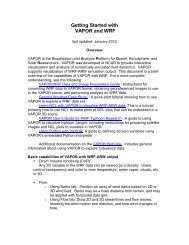C:/VaporTutorial/images - Vapor - UCAR
C:/VaporTutorial/images - Vapor - UCAR
C:/VaporTutorial/images - Vapor - UCAR
Create successful ePaper yourself
Turn your PDF publications into a flip-book with our unique Google optimized e-Paper software.
Use VAPOR/WRF python support<br />
<strong>Vapor</strong> includes several Python routines for various derived variables, such as<br />
radar reflectivity, relative humidity, sea-level pressure, cloud-top<br />
temperature, potential vorticity… (Documented on the VAPOR Website<br />
under “Data analysis with VAPOR”)<br />
• Disable the DVR and the Isosurface<br />
• Write a Python script to create a new variable “dbz” which represents the<br />
simulated radar reflectivity. The python script consists of the two lines:<br />
import vapor_wrf<br />
dbz = vapor_wrf.DBZ(P,PB,QRAIN,0,QSNOW,T,QVAPOR)<br />
• Specify that dbz is an output 3D variable<br />
• Specify that P, PB, QRAIN, QSNOW, T, and QVAPOR are input 3D<br />
variables.<br />
• Visualize the DVR of dbz (click Fit Data and click “fit to view”)<br />
• Compare this with rain, by creating an isosurface of QRAIN=5.e-05<br />
• Animate this over time.<br />
21<br />
vapor@ucar.edu




